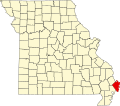References
Municipalities and communities of Mississippi County, Missouri, United States | ||
|---|---|---|
| Cities |  | |
| Villages | ||
| Townships | ||
| CDP | ||
| Other communities | ||
| Ghost towns | ||
| Footnotes | ‡This populated place also has portions in an adjacent county or counties | |
| | This Missouri ghost town-related article is a stub. You can help Wikipedia by expanding it. |
| | This Mississippi County, Missouri state location article is a stub. You can help Wikipedia by expanding it. |